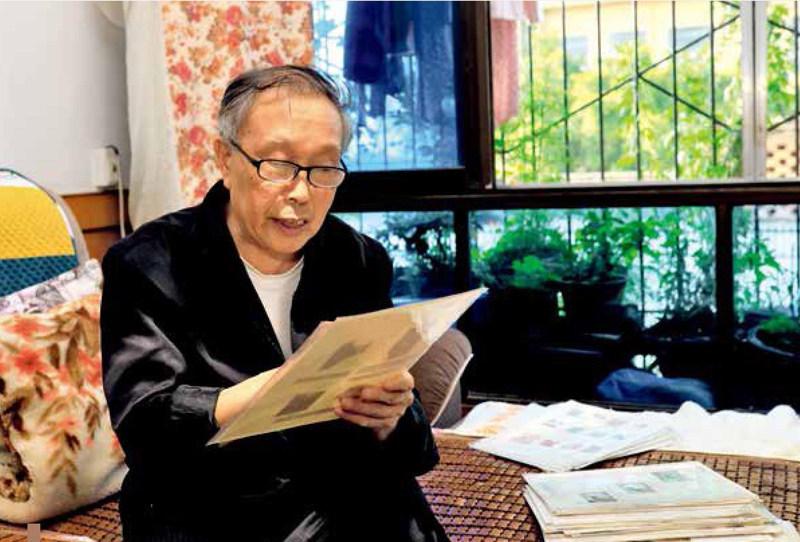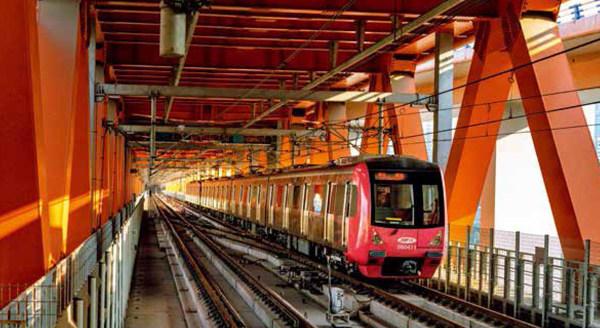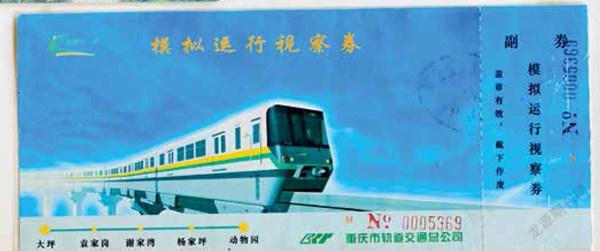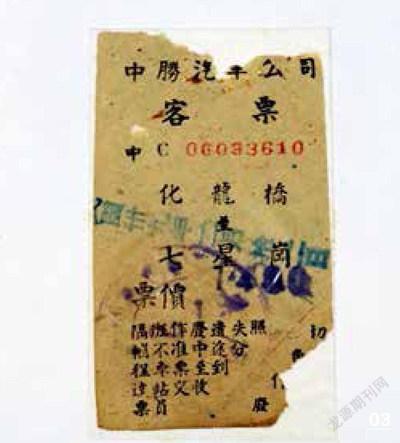嵌在车票里的交通往事
2020-09-10高维微
高维微







八旬老翁宋大有是位车票收藏爱好者,在他收藏的千余张车票中,最早的属于上世纪40年代。翻看这些从旧到新、五花八门的车票,就像在看一幅重庆城市交通发展变迁的剪影。
Song Dayou, an 80-year-old man, is a ticket collector. Among the more than 1.000tickets he has collected. the earliest one can be dated back to the 1940s. Browsingthrough the assortment of tickets. from old to new,is like looking at a silhouetteof Chongqing's urban traffic development and changes.
舊车票和新印章
Old ticket and new seal
6月的一天,我们来到宋大有位于重庆电厂家属区的家。
看着老人小心翼翼打开文件盒的样子,就知道他对里面的东西有多宝贝:泛黄的盒子里是一本厚厚的册子,那些车票被老人套进塑料袋,粘贴在A4纸上,最后再给A4纸加上塑封。
一组泛黄的车票,引起了我们的好奇。那是4枚两指宽的长方形客票,票面边缘都已破损。票面上模糊的字迹显示,这是从化龙桥到七星岗、上清寺等地的车票。
其中一枚化龙桥至七星岗的车票,印有“中腾汽车公司客票”的繁体字,票面上盖着“民圄卅九年二月拾二日”的印戳。
“民国卅九年二月拾二日”,算下来应该是1950年2月12日。这就奇怪了:此时重庆已解放,为什么车票上的印戳时间仍是沿用过去的印章?
类似的情况还出现在另一枚车票上。这张车票的票面印有“國幣”两个繁体字,盖的印章却是“重庆人民汽车公司(会计科)”。众所周知,“國幣”与“重庆人民汽车公司(会计科)”明显相悖,它们为什么会出现在同一张车票上呢?
为了弄清这些车票上的秘密,宋大有曾多方寻找答案。
一次偶然的机会,宋大有找到了原中胜汽车公司老板陈学福的邻居。那位陈老板的邻居说,中胜汽车公司是一家民营汽车公司,公司有五六辆客车,十多名职员。重庆解放后,各行各业百废待兴,印刷业同样艰难,别说印车票,甚至连刻印章都找不到人手,客运公司不得不沿用过去的车票、过去的印章,或者是在旧车票上加盖“重庆人民汽车公司”这样的新公章,以证明车票的有效性。
不过,随着重庆经济社会各项事业步入正轨,这种特殊时期的特殊车票很快退出了历史舞台。
We came to Song Dayou's home in the familyarea of Chongqing Power Plant one day in June.
We could judge how precious the stuff insideto him from the way the old man opened the box:there's a thick brochure inside the box whichturns yellow with age, and the tickets were putinto plastic bags, pasted on A4 paper. and finallylaminated.
A group of yellowed bus tickets aroused ourcuriosity. They were four rectangular tickets. twofingers wide. and the edges of the tickets weredamaged. The blurred writing shows that they aretickets from Hualong Bridge to Qixinggang andShangqing Temple.
One of the tickets from Hualong Bridge toQixinggang is printed with the traditional Chinesecharacter "Ticket of Zhongsheng AutomobileCompany" and bears a stamp reading "February 2,39th year of the Republic of China".
That date should be February 12, 1950 in theGregorian calendar. That's weired: Chongqing hasbeen liberated at this time. Why is the timestampon the ticket still the same as that of the past?
And so is another ticket. The ticket has twotraditional Chinese characters "Chinese Currency"printed on its face, yet the seal reads "ChongqingPeople's Automobile Company (AccountingDepartment) " . Obviously, the "National Currency"dose not belong to the "Chongqing People'sAutomobile Company (Accounting Department)".Why do they appear on the same ticket?
For an answer, Song Dayou has beensearching for many a years.
By chance, Song found the neighbor of ChenXuefu. the former boss of Zhongsheng AutomobileCompany. Chen's neighbor told him thatZhongsheng was a private automobile companywith five or six buses and about 10 employees.After the liberation of Chongqing, all sectors werestruggling with living. So was the print. Peoplecould not even find someone to engrave a seal. notto mention printing tickets. Passenger transportoperators had to reuse the tickets printed in thepast, with the original seals. or affixed new officialseals such as "Chongqing People's AutomobileCompany" to the old tickets to prove the validity.
As Chongqing's economic and socialundertakings heading on the right track. suchspecial tickets quickly withdrew from thehistorical stage.
土飛机和纤大
Tu plane and tracker
重庆山环水绕的独特地理特征,成就了多样化的城市公共交通体系。这也反映在各种各样的车票中。
在宋大有的收藏中,有一枚特殊的铜制车票,这是中国内地第一条客运缆车一一望龙门缆车的车票。在宋大有收藏的所有车票中,这也是年代最久远、最珍贵的一枚。
铜制的方形车票一面刻有“下行客票”“民国37年”等几个字,另一面刻有“缆车”字样,铜票中间还有一个圆孔。宋大有说:“当初我还看到了‘上行客票’,是铜制的圆形票,可惜没有一起收藏。”
1945年5月16日,由我国著名桥梁专家茅以升与梅旸春主持设计的望龙门缆车正式通车,轰动一时,很多市民排队乘坐,享受腾云驾雾的感觉,并戏称为“土飞机”。
“我小时候就住在离望龙门缆车不远的地方。那时候用水都要到江边挑,挑着水爬坡上坎时,最羡慕的就是那些坐缆车的乘客。”宋大有说,他从小在朝天门码头长大,码头上的故事几天几夜都讲不完。
不过,当时的重庆既有缆车这样的先进工具,也有“原始”的作业方式。比如拉纤。在一张拉纤票据上,写着“1956年2月28日,今收到新民塑料厂壹元四角正”“6人”等字样,还盖了一个“重庆港拉滩小组”的公章。
这是一张货船的“拉纤收据”。现在的人可能想不到,在上世纪五六十年代的朝天门一带,还能看到纤夫在拉船。纤夫们工作艰苦,但收入并不高。一般都是拉货,很少拉人。
Chongqing's unique geographical features-surrounded by mountains and waters - haveresulted in a diversified urban public transportationsystem in the city. This is also reflected in thevarious kinds of tickets.
In Song Dayou's collection. there is a specialcopper ticket. which is the ticket of WanglongmenCable Car. the first passenger cable car inmainland China. It's also the oldest and mostprecious one among all the collections.
The copper square ticket is engraved withthe words "Descending Ticket" and "37th year ofthe Republic of China" on one side and "CableCar" on the other. A round hole is designed in themiddle. Song Dayou said: "At the beginning, Ialso saw an 'Ascending Ticket', which is round inshape. Unfortunately. I did not collect it."
On May 16, 1945, Wanglongmen Cable Car.designed by Mao Yisheng and Mei Yangchun,well-known bridge experts in our country, wasofficially opened to traffic. which caused asensation then. Many citizens queued up to take itand enjoyed the feeling of walking in clouds andfog. It was nicknamed "Plane Flying on the Land".
"I lived not far from Wanglongmen CableCar when I was a child. At that time. we have togo to the river to fetch water. When climbing thehills carrying heavy water. we admired those tookthe cable car most." Mr. Song Dayou said thathe grew up at Chaotianmen Wharf. and the storyon the wharf could not be finished for days andnights.
However. Chongqing at that time had bothadvanced tools such as cable car and "primitive"operation methods. For example, boat towing. Mr.Song presented us a boat-towing bill, which writes"Received one yuan and forty cents from XinminPlastic Factory on February 28. 1956" and "sixpeople", with the official seal of "Chongqing PortBoat Bowing Team".
This is a cargo ship's "boat towing receipt".People nowadays may not imagine that in the50s and 60s of 20th century boat trackers werestill seen bowing a ship in the Chaotianmen area.Compared to their hard work. the boat trackersgot a wretchedly low pay. Most of the time, theybowed cargo ships, seldom passenger ships.
從三轮车到康福来
From tricycle to Comfort
宋大有收藏的车票中,有一些“高级货”,“这些车票,当时卖得贵,印刷也很考究、精美,算得上是奢侈品。”
比如一组上世纪五十年代的三轮车票。这种“重庆市三轮车客票”票面中间是车夫卖力蹬三轮车的图案,三张票分别标明“一公里定额票价0.06”“二公里定额票价0.12”“十公里定额票价0.6”。“计费方式和现在的出租车一样,不过当时坐三轮车是高消费。”当时重庆公交车不多,马路又窄,三轮车是公共交通一种重要的补充工具。那时一碗小面才8分钱,一股老百姓轻易还是舍不得坐三轮车。
虽说收藏了一些“高级货”,但宋大有却有遗憾,他没能收藏到“康福来”的车票。
老宋口中的“康福来”,是成立于1984年的重庆康福来客运有限公司运营的豪华客车。
《康福来重振雄风——重庆康福来实业公司改革与发展纪实》一文记载:1984年,春满人间的日子。在中国南大门广州,一个由20辆日本皇冠豪华轿车、40辆新颖别致的丰田中巴、30辆造型独特的日野大巴共90辆进口汽车组成两公里长的车队出发了。这是中国内地第一个由国外引进的庞大而豪华的车队。像一条巨龙,穿越南部中国,一路雄风浩荡,来到了山城重庆,进入了刚成立的重庆康福来客运有限公司的大门。
那时重庆人还没有招手即上的“中巴”的概念,康福来公司的客车刷新了人们的认知。这些中巴车有空调、软皮座位,乘坐舒适,招手即停,车身上“康福来”三个字吉利顺口,大受市民欢迎,以至于后来“康福来”三个字成了中巴车的代名词,还给重庆人留下了一句“手一抬,康福来”的言子。
There were some "premium" tickets inSong's collection. which, "expensive, exquisitelyprinted. can be considered luxuries."
He showed us a group of tricycle ticketsfrom the 1950s. In the middle of the face of thisgroup of "Chongqing Tricycle Tickets" is a driverpedaling the tricycle hard. The three tickets aremarked "Fixed fare: 0.06 yuan per kilometer"."Fixed fare: 0.12 yuan two kilometers " and "Fixedfare: 0.6 yuan ten kilometers". "The chargingmethod is the same as that of taxis now. but it wasexpensive to take tricycles at that time." Therewere few buses on the narrow roads in Chongqingthen. Tricycles thus became an importantsupplementary tool for public transportation. Buta bowl of noodles back then cost only 8 cents. Somany a budget-conscious people were reluctant totake tricycles.
Although he collected some "premium" ones.Song Dayou felt a deep regret that he did not get asingle ticket of "Kangfulai" .
The "Kangfulai" in question is a luxury busoperated by Chongqing Kangfulai PassengerTransport Co.,Ltd., which was established in1984.
The article "Kangfulai Gets its SwaggerBack --On-the-Spot Record of Reform andDevelopment of Chongqing Kangfulai IndustrialCompany" records that. in Guangzhou. thesouthern gate of China. a two-kilometer-longmotorcade of 90 imported cars, consisting of 20Japanese Toyota Crown luxury cars, 40 noveland chic Toyota minibuses and 30 unique Hinobuses. set off in a spring day of 1984. This isthe first large and luxurious motorcade importedin mainland China. Taking the shape of a hugedragon, it crossed southern China and came tothe mountain city of Chongqing. entering the gateof the newly established Chongqing KangfulaiPassenger Transport Co.,Ltd.
As the localities of Chongqing had no ideaabout the wave-and-stop "minibus" then. thebuses of Kangfulai Company renewed people'sunderstanding. Equipped with air conditioning andsoft leather seats. these wave-and-stop minibusesprovided passengers with very comfortableexperience and won popularity immediately. Theword "Kangfulai" on the bus body is auspiciousand easy to read. thus later becoming a synonymfor minibuses. leaving Chongqing people witha widely spread saying "Hand lifted. Kangfulai(literally felicity come)".
